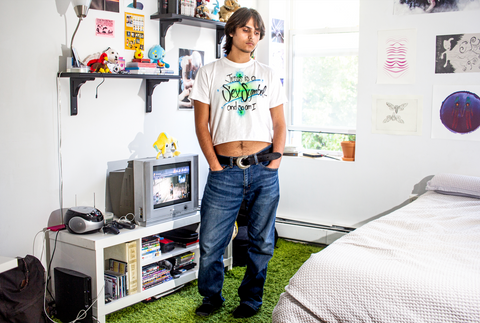LAILA ANNMARIE STEVENS PHOTOGRAPHS GEN Z ARTISTS

GBA: Can you give a brief background of your practice and how you met the crew at GBA?
Laila: During high school, I realized I was passionate about photographing my friends and other youth in my Queens community and New York youth in general. Particularly marginalized youth, women, and women of color, as those were the people that surrounded me most in high school. I realized there was a connection between my passions for activism and art, so I sought out youth organizations throughout NYC that aligned with that. One of these organizations was the Sadie Nash Leadership Project, a youth activism program for girls of color seeking to make a change within their communities. A mentor there connected me to Scope of Work (SOW), a youth-based organization striving to uplift artists of color aged 17-24 in New York. And then, my mentor at SOW introduced me to Karen (GBA Cofounder). We first worked on a project for Cultured Magazine, where she had written a piece, and I did the photography for it. After that, I stayed in touch with Karen, did some photography for the GBA newsletter, and did the Gen Z shoot!
GBA: Can you speak a bit more about your experiences working with these youth organizations and your experience working with us at GBA?
Laila: Organizations that are dedicated to promoting the work of young artists are crucial in today's age, especially in an industry that does not highlight youth artists and measures experience based on how many years you've worked in the industry. When I heard that Karen and Derek were doing GBA, I was immediately intrigued, mainly because my practice is focused on photographing youth. What I was exploring was directly in line with GBA. I even had something in my mind where I wanted to photograph other artists my age before the Gen Z show existed.
GBA: Tell me a bit about your observations when photographing the Gen Z show artists.
Laila: I found themes in the work that were aligned with their spaces. The work has a sense of dreaminess, nostalgia, and an otherworldly aspect. It veers away from documentation, which I focus on as a photographer. But the artists are going into abstract worlds, creating alternate universes for their subjects and protagonists. And in their studio spaces, there are so many bright colors! The rooms were tight, and artists worked right next to their beds using whatever window lighting was accessible. But they all created beautiful art within those spaces that felt outside the confines of a small home. I identified with Cristina's room and background as we're both from Queens, especially because she is a young artist living with her family, like me. I related to having a career in NYC and living with family simultaneously.

Laila Annmarie Stevens photographs Cristina Loukopoulos
GBA: Were there any specific connections you made from items in the spaces to the artwork?
Laila: Yes. Kyle Cobian had a very electronic Y2K set up in his space that aligned with the colors he uses in his photographs. He also told me he shoots a lot in his room, which makes sense. Kyle had this green carpet in his space that was like grass, which aligns with this sense of otherworldliness, the idea that an interior space could contain something that's exterior.
GBA: What advice would you give to younger Gen Z artists?
Laila: Find people or a place that intrigues you, and continue exploring all aspects of that. See what you can create. Anything that touches your heart and interests you is valuable and worth exploring.
GBA: Do you work differently when photographing for personal practice versus publications?
Laila: I don't, and that's because I've established a style for myself. I've been told there's an intimacy in my photographs, whether for a publication or a personal project. So you can see that common theme throughout both practices. I am equally as nervous when shooting for either, but if I stay true to being a human and relating to the subject, that's what matters when creating a beautiful image. I've spoken to photographers who spend days or weeks with their subjects because the importance of their stories is knowing them as humans instead of simply using them for a photo. You will get a more meaningful image if you work with someone and learn who they are as a person.
GBA: If you could go back in time and photograph anything, what would it be?
Laila: Any queer liberation march in the 90s or early 2000s. Photographing any pivotal leader or change-maker would be incredible to experience.